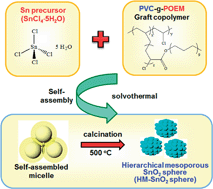One-pot synthesis of hierarchical mesoporous SnO2 spheres using a graft copolymer: enhanced photovoltaic and photocatalytic performance†
Abstract
We synthesized hierarchical mesoporous SnO2 (HM-SnO2) spheres with a large surface area (85.3 m2 g−1) via a one-pot controlled solvothermal process using tin chloride pentahydrate and graft copolymer, i.e., poly(vinyl chloride)-g-poly(oxyethylene methacrylate) (PVC-g-POEM) as a Sn precursor and structure directing agent, respectively. Solid-state dye-sensitized solar cells (ssDSSCs) fabricated with HM-SnO2 spheres on an organized mesoporous SnO2 interfacial (om-SnO2 IF) layer as the photoanode had a long-term stable efficiency of 3.4% at 100 mW cm2, which was much higher than that of ssDSSCs with a photoanode comprising nonporous SnO2 (NP-SnO2) spheres (1.9%). We attributed the enhanced device performance of ssDSSCs fabricated with the HM-SnO2 photoanode to the well-organized hierarchical structure with dual pores (23.5 and 162.3 nm), which provided a larger surface area, improved light scattering, and decreased charge recombination compared to the nonporous SnO2 (NP-SnO2) photoanode. We confirmed this by reflectance, incident photon to current conversion efficiency (IPCE), and intensity modulated photocurrent/voltage spectroscopy (IMPS/IMVS) measurements. Introduction of an om-SnO2 IF layer between the HM-SnO2 spheres and fluorine-doped tin oxide (FTO) substrate enhanced light harvesting, increased electron transport, reduced charge recombination, and decreased interfacial/internal resistance. Photocatalytic tests indicated that HM-SnO2 spheres showed high activity with good recyclability for photodegradation of methyl orange under UV light irradiation.


 Please wait while we load your content...
Please wait while we load your content...